Health + Convenience = Market Opportunity
Creative concepts coupled with innovative processing and packaging technologies are yielding a steady stream of new product options that are both easy and healthful.

Freeze-dried fruit. Slow-baked meat snacks in bar form. Minimally processed sweet potatoes cut into curls. Protein-packed grab-and-go meal kits. Convenience is getting healthier as entrepreneurs with a passion for good-for-you foods and large food companies with the vision to recognize major market opportunities introduce a growing assortment of innovative products that are both convenient and healthful.
“You’re seeing more and more products that are promoting health and wellness and convenience at the same time,” says Tom Vierhile, innovation insights director and an expert on new product introductions with Datamonitor Consumer/Progressive Digital Media, Fairport, N.Y. It’s a positioning that makes perfect sense because convenience and health both routinely rank near the top on lists of what consumers say they want from food and beverage products (IFIC 2013). And these days many consumers are at least taking a stab at better-for-you eating. Healthful foods are expected to be a $1 trillion dollar business by 2017, according to Euromonitor (Gagliardi 2015).
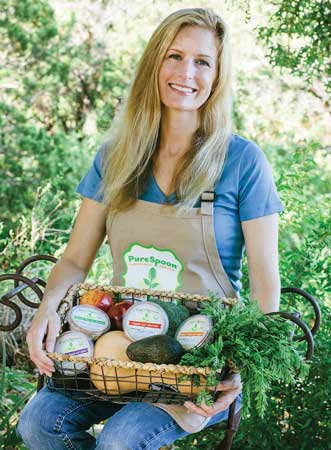 Entrepreneurs like Alyson Eberle of Austin, Texas, are using cutting-edge technologies to turn their new product concepts into reality. Eberle, who began making fresh organic baby food after the birth of her daughter four years ago, opted to use high pressure processing (HPP) because of its ability to preserve taste and nutrient content. “It’s expensive, but my hope is that as it gains traction, the pricing will go down for everybody,” says Eberle. Her 11-item line of Pure Spoon baby foods and purees, which retail for $2.69 to $2.99 per 4-ounce container and have a 65-day shelf life, are currently in only regional distribution but will be introduced in select Target stores by early next year.
Entrepreneurs like Alyson Eberle of Austin, Texas, are using cutting-edge technologies to turn their new product concepts into reality. Eberle, who began making fresh organic baby food after the birth of her daughter four years ago, opted to use high pressure processing (HPP) because of its ability to preserve taste and nutrient content. “It’s expensive, but my hope is that as it gains traction, the pricing will go down for everybody,” says Eberle. Her 11-item line of Pure Spoon baby foods and purees, which retail for $2.69 to $2.99 per 4-ounce container and have a 65-day shelf life, are currently in only regional distribution but will be introduced in select Target stores by early next year.
Brooklyn, N.Y.–based Noha Waibsnaider was inspired to introduce her line of Peeled Snacks organic dried fruit snacks more than a decade ago because she felt that there weren’t enough healthful snack options. She believes that the time is definitely right for healthy/convenient fare. “Consumers and retailers have changed dramatically in the last decade,” she says. “When we launched, we had to do a lot of education. … Now consumers are looking for minimally processed foods with strong nutrition profiles. They have a lot more information about what’s good for them.”
The marketplace opportunities that healthy/convenient products present haven’t been lost on major food companies. At the annual Sweets & Snacks Expo in Chicago this spring, the big news from confectionery giant Mars, McLean, Va., was the rollout of its 150-calorie goodness knows snack squares in which fruits, nuts, oats, and a thin layer of dark chocolate combine to supply a portion-controlled treat that blends health and indulgence. Meanwhile, Mars’s candy category rival, Hershey, Pa.–based Hershey Co., branched out this year with the acquisition of Krave, Sonoma, Calif., maker of a line of all-natural, minimally processed jerky, and Mondelēz International, Deerfield, Ill., acquired Enjoy Life Foods, a private company that makes a wide array of gluten-free, “allergen-friendly” products. In the healthful beverages segment, pioneering cold-pressed juice maker Suja, San Diego, Calif., partnered with The Coca-Cola Co., Atlanta, in a bid to expand distribution for the company’s line of fresh organic beverages made with ingredients that are not genetically modified.
--- PAGE BREAK ---
A Healthy Spin on Snacking
While the snacks category is still dominated by several major players (most notably market leader PepsiCo), the snacking landscape has changed in recent years thanks to the proliferation of new specialty product lines, many of which have a healthful positioning (IBISWorld 2015).
When Internet grocery delivery service Peapod, Skokie, Ill., tallied totals for its best-selling snack foods for the back-to-school period late this summer, a six-pack of SkinnyPop Popcorn came in at No. 1 on the list, an indication that many families are making a shift to “sending natural, healthier snacks to school,” notes Tony Stallone, Peapod’s vice-president of fresh markets (Peapod 2015).
Data from market research firm Mintel, Chicago, supports Peapod’s statistics. In an Internet survey conducted in January 2015, one-third of those polled said they were snacking more healthfully than in the prior year (Mintel 2015). Six out of 10 (60%) said they wished there were more healthy snack options in the marketplace, and that total rose to 70% in households with children. In the same survey, one-third of all shoppers and 42% of those with children indicated that there is a shortage of conveniently packaged snacks, including products that come in single-serve portions or with resealable packages (Mintel 2015). (See Figure 1 for more details about the health attributes that various demographic groups say are important for snacks to deliver, according to Mintel research.)
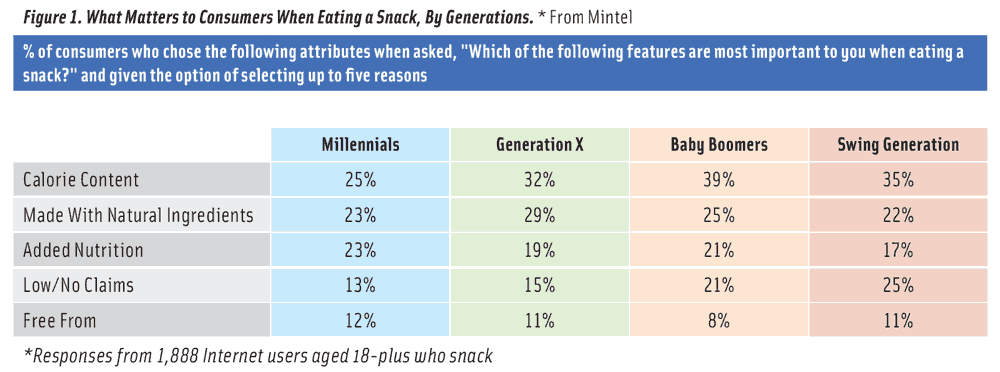 Walmart is catering to such consumer preferences with the launch last month of a nine-item line of Sunkist Fruit Chips and Trail Mixes packaged in colorful, resealable standup bags and merchandised on racks in the produce department. With a $2.99 price point in Walmart, the products have a mainstream positioning, says Nick Desai, managing partner of Snack It Forward, the Los Angeles–based marketer of the Sunkist snacks.
Walmart is catering to such consumer preferences with the launch last month of a nine-item line of Sunkist Fruit Chips and Trail Mixes packaged in colorful, resealable standup bags and merchandised on racks in the produce department. With a $2.99 price point in Walmart, the products have a mainstream positioning, says Nick Desai, managing partner of Snack It Forward, the Los Angeles–based marketer of the Sunkist snacks.
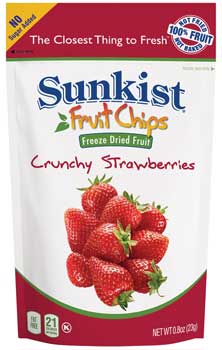 Snack It Forward launched the Sunkist products in 2014, and Walmart tested them in 1,200 stores earlier this year. That experience and the company’s own focus group testing convinced the Snack It Forward team that the new line—which includes four varieties of freeze-dried fruit (apple, grape, banana, and strawberry) and five trail mix SKUs in varieties like Mango Dark Chocolate Blend and Breakfast Espresso & Granola Blend— would benefit from some tweaks.
Snack It Forward launched the Sunkist products in 2014, and Walmart tested them in 1,200 stores earlier this year. That experience and the company’s own focus group testing convinced the Snack It Forward team that the new line—which includes four varieties of freeze-dried fruit (apple, grape, banana, and strawberry) and five trail mix SKUs in varieties like Mango Dark Chocolate Blend and Breakfast Espresso & Granola Blend— would benefit from some tweaks.
“The big thing that we learned along the way,” says Desai, “is that people don’t understand what freeze-dried is, and in the store you have very little time to explain what the product is. We did a lot of homework and came up with the concept of fruit chips.” He believes that the concept will resonate with consumers because the fruit chips are crunchy and snackable, and consumers already are familiar with veggie chips, so the leap to fruit chips shouldn’t be too great.
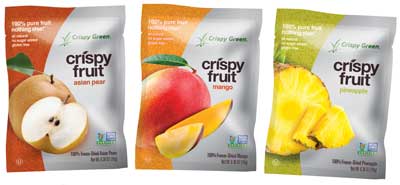 Marketers of Crispy Fruit freeze-dried fruit snacks from Crispy Green, Fairfield, N.J., like to think of their products as “fruit to go” thanks to their easy portability. “The market [for healthful snacks] has grown tremendously and continues to outpace the growth of most food categories,” says Mark McHale, national sales director for Crispy Green.
Marketers of Crispy Fruit freeze-dried fruit snacks from Crispy Green, Fairfield, N.J., like to think of their products as “fruit to go” thanks to their easy portability. “The market [for healthful snacks] has grown tremendously and continues to outpace the growth of most food categories,” says Mark McHale, national sales director for Crispy Green.
Vierhile says that veggie snacks in new and different forms were front and center at the Natural Products Expo East trade show held in Baltimore this fall. One example he cites is Broccoli Bites from Rhythm Superfoods, Austin, Texas, which are described as bite-sized broccoli floret snacks tossed in a light dressing made with nuts, seeds, vegetables, herbs, and spices and slowly dehydrated in a process that allows them to maintain the nutritional value of raw broccoli.
--- PAGE BREAK ---
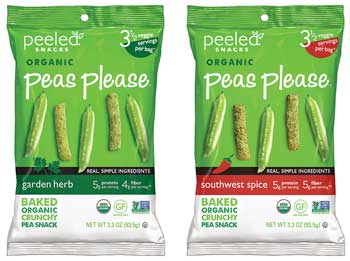 Peeled Snacks recently debuted its first vegetable snack, Peas Please, a crunchy, savory baked snack made from organic whole peas and whole grain brown rice that comes in three varieties and is packaged in 3.3-ounce bags.
Peeled Snacks recently debuted its first vegetable snack, Peas Please, a crunchy, savory baked snack made from organic whole peas and whole grain brown rice that comes in three varieties and is packaged in 3.3-ounce bags.
In addition to lots of fruit-and veggie-based fare, Natural Products Expo East also showcased a new variation on meat snacks: Wilde Bars, 100-calorie, slow-baked bars made with premium lean meat raised without growth hormones or antibiotics, plus ingredients such as ancient grains, seeds, superfruits, vegetables, herbs, and spices. Available from Wilde Snacks, Boulder, Colo., the meat bars contain 10–11 grams of protein and come in fun flavors like Strawberry Black Pepper and Maple Bacon Blueberry.
Expect to see snack category innovation remain focused on improving the nutritional quality of snacks, with the majority of new snack product introductions formulated to be lower in fat, sodium, sugar, and calories than traditional snacks and many new offerings enhanced with nutrition-boosting ingredients, including seeds, dehydrated vegetables, and beans, not to mention nontraditional ingredients like taro root and butternut squash (IBISWorld 2015).
Making Produce More Convenient
With their bountiful stores of healthful nutrients and phytochemicals, fresh fruits and vegetables are perhaps the ultimate examples of healthful foods. In recent years, they have become even more convenient food choices thanks to processing and packaging technologies that make it possible to deliver extended shelf-life products that are prewashed, peeled, sliced, and diced.
About half of shoppers buy such value-added produce at least somewhat regularly, according to recent data from the Food Marketing Institute (FMI), Arlington, Va. (FMI 2015). And sales of value-added products outpace the overall produce market—up 13% this year versus last, according to FMI (FMI 2015).
Produce marketers have understood the market opportunities that preprepared, easily portable produce represents for decades, but it’s taken awhile for the packaging and processing technologies to catch up, says Bob Whitaker, chief science and technology officer of the Produce Marketing Assoc., Newark, Del. Today, however, thanks to modified atmosphere packaging (MAP), high-tech packaging films, and state-of-the- art equipment for gentle minimal processing of fruits and vegetables, produce marketers have gotten extremely creative.
Bringing produce to market is a battle against time and distance. “When you harvest a vegetable or fruit, you basically start a clock,” says Whitaker, “and that clock is the time it is going to take that vegetable or fruit to degrade.” Without access to the nutrients it was getting from water in the soil, the fruit or vegetable continues to respire, but begins to use up its internal reserves (sugars, nitrogen compounds, and moisture) and starts to deteriorate. MAP technologies and permeable packaging films are used together to create an environment that slows respiration down, effectively putting the product to sleep and thus extending its shelf life. Different kinds of fruits and vegetables have different oxygen transmission rates. “So there are different solutions for different products,” says Whitaker. “You can use a whole different array of films. There are some very complex plastics that actually change their level of permeability based on the temperature. … And that gives us a lot more flexibility and a lot more consistency with the quality of the product.”
MAP allows Naturipe Farms, Estero, Fla., to achieve 21-day shelf life for its single-serving packages of blueberries and shelf life of 15 days for its blueberry/mango and blueberry/grape combinations, all of which are packaged in PET trays. The products have been on the market for a year-and-a-half, and Brian Jenny, Naturipe senior director/general manager for value-added/fresh products, says they have been well received, noting that “more and more retailers across the country are allocating space for healthy grab-and-go snacks.” Naturipe has focused on supermarket distribution but is gaining ground in the convenience channel, according to Jenny.
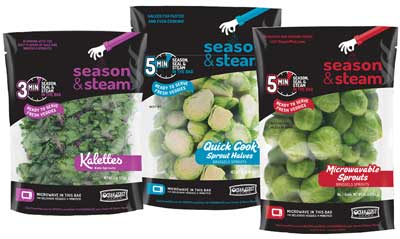 Ocean Mist Farms, Castroville, Calif., incorporates several packaging benefits in its line of Season & Steam brussels sprouts and kalettes. The veggies come in standup pouches for better visibility in the store and boast zipper-seal packaging that allows the consumer to open the package, add seasoning, reseal it, and cook the vegetables in a microwave.
Ocean Mist Farms, Castroville, Calif., incorporates several packaging benefits in its line of Season & Steam brussels sprouts and kalettes. The veggies come in standup pouches for better visibility in the store and boast zipper-seal packaging that allows the consumer to open the package, add seasoning, reseal it, and cook the vegetables in a microwave.
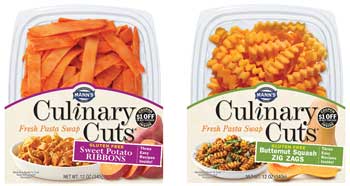 New Culinary Cuts Butternut Squash Zig Zags and Sweet Potato Ribbons from Mann Packing Co., Salinas, Calif., are positioned as alternatives to pasta. Each 12-ounce package includes three recipes to help stimulate shoppers’ culinary creativity. The new product line performed well in test market, says Kimberly St. George, director of marketing and communications. “It hits every trend—vegan, low-carb, and fresh,” she observes.
New Culinary Cuts Butternut Squash Zig Zags and Sweet Potato Ribbons from Mann Packing Co., Salinas, Calif., are positioned as alternatives to pasta. Each 12-ounce package includes three recipes to help stimulate shoppers’ culinary creativity. The new product line performed well in test market, says Kimberly St. George, director of marketing and communications. “It hits every trend—vegan, low-carb, and fresh,” she observes.
Other notable convenient/healthful products include Green Giant Fresh Cauliflower Crumbles, which steam in their packaging and are positioned as a versatile, healthful ingredient in recipes ranging from soups to chocolate cake, and fresh-cut watermelon in a patent-pending gusset bag from Maglio Cos., Glendale, Wis. The resealable watermelon packaging features a large window to show off the product and is designed keep a watermelon slice fresh for 11 days from the time it is cut.
--- PAGE BREAK ---
Healthy Products Make Inroads in C-Stores
Need more evidence that the health + convenience positioning has major market potential? Consider that, according to a new Hudson Institute analysis commissioned by the National Association of Convenience Stores (NACS), 75% of convenience store customers say that they are eating more healthfully than they did in the past (Hudson Institute 2015). Increasingly, savvy convenience retailers are moving to capitalize on the sales potential that fresh, healthy fare affords. (Read more about the importance of better-for-you products in the convenience channel in a Food Technology Online Exclusive article at ift.org/food-technology/current-issue.)
 Just this fall, Square One Markets, a Bethlehem, Pa.–based c-store chain, began testing a line of fresh food dinner kits targeted to time-challenged families looking for fast but healthful meal solutions. Aviva Goldfarb, a cookbook author and founder of The Six O’Clock Scramble, an online menu-planning site based in Chevy Chase, Md., worked with NACS to develop the pilot program.
Just this fall, Square One Markets, a Bethlehem, Pa.–based c-store chain, began testing a line of fresh food dinner kits targeted to time-challenged families looking for fast but healthful meal solutions. Aviva Goldfarb, a cookbook author and founder of The Six O’Clock Scramble, an online menu-planning site based in Chevy Chase, Md., worked with NACS to develop the pilot program.
“Convenience stores are interested in meeting the increasing demand for healthier food, and they have discovered [via NACS research] that a lot of women shopped for gas in the afternoon,” says Goldfarb. She believes the beauty of the new meal-kit program is that it’s reaching people at a destination that is already part of their weekly routine. “I think a barrier to making dinner for a lot of people is that they don’t feel they have time to stop at the store. … [But] if they are already stopping for gas, they don’t have to make an extra stop.”
Priced at about $20, each of The Six O’Clock Scramble Fresh & Fast Family Dinner Kits comes in a reusable bag and includes a recipe card and all the ingredients needed to prepare a healthful dinner for a family of four in less than 30 minutes. Goldfarb hopes the 10-week market test will provide the market intelligence needed to allow the program to expand.
Convenience stores have traditionally accounted for only a tiny percentage of total produce sales, but that is changing. In 2014, according to Nielsen data supplied by NACS, convenience channel sales of fresh fruits and vegetables shot up by 10.3%—almost four times the overall 2.7% growth rate of U.S. produce sales (NACS 2015a).
Nearly six in 10 convenience retailers (57%) sell packaged salads, and almost half (47%) retail precut fruits and vegetables (NACS 2015a). Among retailers responding to a June 2015 survey, close to a third (30%) reported expanding their cut fruit and vegetable offerings in the preceding six months, and 21% of respondents said they were offering more salads (NACS 2015b). NACS is encouraging retailers’ move to merchandise more produce. Last year the association announced a partnership with United Fresh Produce Assoc., Washington, D.C., and the groups have teamed up to identify best practices in produce merchandising for c-store retailers.
Jenny has noticed the difference. He says that convenience stores are making additional space for products like Naturipe snack-size fruit packages, often in a cooler positioned near the checkout counter. “We’ve talked to a lot of convenience stores across the country,” says Jenny. “It’s amazing how that channel has changed.”
Better-for-you products like nuts, trail mixes, and protein bars currently represent 18% of the snacks sold in convenience stores, so it’s clear that healthy snacking has arrived in this channel (NACS/ United Fresh 2015). And in the survey cited earlier, 41% of convenience operators polled said they were expanding their selections of healthy snack bars (NACS 2015b).
The world’s largest convenience chain debuted a better-for-you private-label brand in January of this year with the rollout of two fruit and nut bars, Cranberry Cashew and Pistachio and Mixed Berries, under the 7-Eleven Select GO!Smart banner. The Go!Smart lineup also includes gourmet light popcorn and sprouted tortilla chips.
Waibsnaider of Peeled Snacks says she has seen the market shift in the 10-plus years she has been in business. Her company’s premium organic snacks are stocked by leading convenience store retailers, including Wawa, Sunoco, QuickChek, Speedway, RaceTrac, and Circle K. “We’ve found convenience stores are turning to Peeled Snacks’ organic fruit and vegetable products more every season,” she says. “With revenue dropping from traditional convenience staples like sodas and junk food, convenience sellers have been looking to brands like Peeled Snacks to drive growth,” she contends. “In some places—like Wawa and Sunoco—healthy snack growth has outpaced every other category.” It’s just one more example of the convergence of health and convenience.
--- PAGE BREAK ---
Healthy, Convenient, and Distinctive
In addition to healthy snacks and value-added produce, the health + convenience category includes a variety of new offerings that are not as easy to categorize. Here’s a sampling.
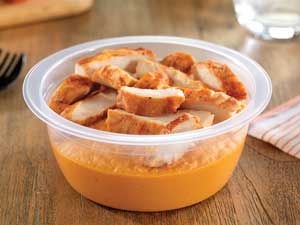 • Not Just Another Hummus. Introduced this spring by Pure Mediterranean Foods, Elk Grove Village, Ill., Hummus Plus, a refrigerated meal-on- the-go that pairs hummus with seasoned chicken, takes its inspiration from a variety of market trends, says David Gacom, vice-president of sales and marketing. These include the recent popularity of fast casual Mediterranean restaurants as well as the increasing emphasis by supermarkets on fresh fare sold in the perimeter of the store. Then there’s consumers’ undiminished enthusiasm for high-protein products. With up to 28 grams of protein per item, Hummus Plus definitely packs a protein punch.
• Not Just Another Hummus. Introduced this spring by Pure Mediterranean Foods, Elk Grove Village, Ill., Hummus Plus, a refrigerated meal-on- the-go that pairs hummus with seasoned chicken, takes its inspiration from a variety of market trends, says David Gacom, vice-president of sales and marketing. These include the recent popularity of fast casual Mediterranean restaurants as well as the increasing emphasis by supermarkets on fresh fare sold in the perimeter of the store. Then there’s consumers’ undiminished enthusiasm for high-protein products. With up to 28 grams of protein per item, Hummus Plus definitely packs a protein punch.
Available in 6-ounce and 8-ounce versions, Hummus Plus is currently stocked by about 3,500 retailers nationwide despite the fact that it doesn’t fit neatly into any existing product category. Most of the distribution is concentrated in supermarkets, but Gacom says the company is focused on taking the product line into new channels. Pure Mediterranean Foods also plans to expand the Hummus Plus product portfolio.
• Muffins Made Easy. FlapJacked Mighty Muffins from FlapJacked, Westminster, Colo., are another product that’s hard to categorize. These single-serving muffin mixes in a cup are formulated with whey protein isolate and pea protein isolate and require only the addition of water and 35 seconds of microwaving to yield a gluten-free, high-protein, 220-calorie muffin. The fact that Mighty Muffins are enhanced with probiotics helped make them one of the attention-getters at Natural Products Expo East this fall. Now available in the Vitamin Shoppe and GNC retail chains, the muffins come in double chocolate and cinnamon apple varieties, with peanut butter and maple pumpkin slated to join the lineup soon.
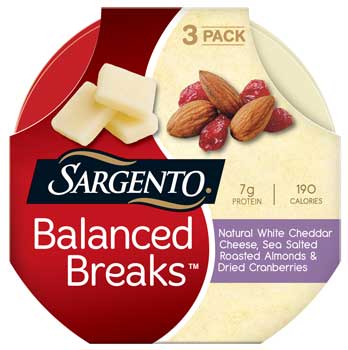 • Snacks From the Dairy Case. For on-the-go cheese lovers looking for something a bit heartier and more exotic than a stick of string cheese—but still with the benefit of portion control—Sargento Foods, Plymouth, Wis., introduced its Balanced Breaks snacks that combine chunks of natural cheese, roasted nuts, and dried fruits. Each of the four varieties of Balanced Breaks snacks features 7 grams of protein and 170–190 calories. The new cheese, nut, and fruit combos are now available in supermarkets, and Sargento plans to introduce them into the convenience channel next year, says Rob Tune, senior marketing manager—adjacencies.
• Snacks From the Dairy Case. For on-the-go cheese lovers looking for something a bit heartier and more exotic than a stick of string cheese—but still with the benefit of portion control—Sargento Foods, Plymouth, Wis., introduced its Balanced Breaks snacks that combine chunks of natural cheese, roasted nuts, and dried fruits. Each of the four varieties of Balanced Breaks snacks features 7 grams of protein and 170–190 calories. The new cheese, nut, and fruit combos are now available in supermarkets, and Sargento plans to introduce them into the convenience channel next year, says Rob Tune, senior marketing manager—adjacencies.
Online Exclusive: Targeting Wannabe Healthy Eaters in the C-Store
Read more about the potential of better-for-you products in the convenience channel at ift.org/food-technology/current-issue.
Mary Ellen Kuhn is executive editor of Food Technology magazine ([email protected].)
References
FMI. 2015. “FMI Launches Inaugural Power of Produce Study.” Press release, June 9. Food Marketing Institute, Arlington, Va. fmi.org.
Gagliardi, N. 2015. “Consumers Want Healthy Foods—and Will Pay More for Them.” Forbes, Feb. 18. forbes.com.
Hudson Institute. 2015. Health & Wellness Strategies for the Convenience Store Sector. Washington, D.C. hudson.org.
IFIC. 2013. Food & Health Survey. International Food Information Council, Washington, D.C. foodinsight.org.
IBISWorld. 2015. IBISWorld Industry Report 31191 Snack Food Production in the U.S. Los Angeles. ibisworld.com.
Mintel. 2015. Snacking Motivations and Attitudes—U.S. Mintel Group, Chicago. mintel.com.
NACS. 2015a. “New Resource Helps Retailers Assess Fresh Options.” Press release, Aug. 3. National Assoc. of Convenience Stores, Alexandria, Va. nacsonline.com.
NACS. 2015b. “Convenience Stores Grow Sales, Add More Fresh Foods in First Half of 2015.” Press release, June 30.
NACS/United Fresh. 2015. “Building the Case for Produce at Convenience Stores.”
Peapod. 2015. “Back to School Spotlight: Healthy Snacks Claim Top Spot in Chicago Lunchboxes.” Press release, Aug. 24. Peapod, Skokie, Ill. peapod.com
